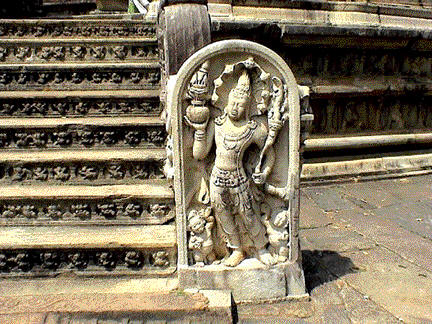 Guardians of ancient religious buildings Guardians of ancient religious buildings
When you visited ancient temples, you would have seen the beautiful
guard stones that adorn their entrances. Weren’t they really
fascinating? Today, we bring you information about some of these guard
stones or muragal as they are known locally.
They are also known as doratupala figures. Whatever we may call them,
they are some of the finest creations of ancient Sinhalese artwork. As
you may have seen, guard stones are vertical stone slabs with the figure
of a celestial (heavenly) being carved in semi-relief(a style used in
carving) and erected at the entrance to religious buildings.
They provide support to the heavy stone balustrade(short pillars
supporting a rail). These guard stones were plain in the beginning. It
was much later that they came to be sculptured with symbols significant
of prosperity and protection. The best example of a guard stone is seen
at the Abhayagiri complex. Now, let us give you details of the figures
carved in those verticalslabs.
Naga-Raja
 The cobra was considered the guardian of water and treasure.
Zoomorphic (the use of animal figures in art and design or of animal
symbols in literature) sculptures of multi-headed cobras have been found
at the sluices of reservoirs, and at the four corners of relic chambers
enshrined in dagabas. The cobra was considered the guardian of water and treasure.
Zoomorphic (the use of animal figures in art and design or of animal
symbols in literature) sculptures of multi-headed cobras have been found
at the sluices of reservoirs, and at the four corners of relic chambers
enshrined in dagabas.
The concept of protection could have arisen out of popular belief
that when people die they are reincarnated as cobras to protect the
treasures they had buried in their previous lives.
This idea of protection is believed to have been incorporated in the
third and final stage of development of the guard stones, not as a
zoomorphic symbol, but as an anthropomorphic (depiction as human
figures) one of a cobra king or naga-raja.
The Naga-Raja is gracefully carved to indicate movement and poise. In
one hand he holds the pot of plenty (punkalasa) and in the other, a
sprouting branch complete with leaves, buds and flowers.
The body is princely dressed and ornamented. Around the head is a
five-hooded, seven-hooded and occasionally a nine-hooded cobra.
This indicates that the Naga-Raja has taken the place of the Bahirawa
as a guardian of wealth and an omen of prosperity. Sankha and Padma have
been diminished to two minor figures or gana at the feet of the Naga-Raja.
There may be one or two gana on the guardstones.
The very best Naga-Raja guardstones may be seen at the Ratanaprasada
in Anuradhapura and the Vatadage in Polonnaruwa. In the Polonnaruwa
guard stone, there are two gana figures, while there is only one at the
Ratanaprasada. The headdress and ornaments of the Naga-Raja figures have
been exquisitely moulded.
In the Ratanaprasada guard stone, the arch above the figure is also
profusely carved. There is a double makara head at the apex, and a
makara head at each end of the base of the arch. Lions and dancing human
forms spill out of the mouths of these makara.
We hope you learnt something new about the guard stones in Sri Lanka.
Next time you visit Anuradhapura or Polonnaruwa, pay attention to the
figure in the guard stone. Then you would know the purpose they served.
Punkalasa
 Guard stones had gone through three major stages in their
development. Using the punkalas design was the first stage in this
development. Guard stones had gone through three major stages in their
development. Using the punkalas design was the first stage in this
development.
In ancient days, there was a custom to keep pots of water with
flowers (usually of the coconut palm variety) and budded twigs in front
of buildings on important occasions. Even nowadays, such pots known as
punkalas, are kept in front of wedding poruwas and also used at other
important occasions.
Ancient architecture may have been designed to bring prosperity to
buildings all throughout the year. Examples of carved punkalasa guard
stones can be seen in the archaeological museum in Anuradhapura. The
“pots of plenty” in these specimens are placed on a lotus-moulded
pedestal.
Bahirawa
 In the second stage of development, dwarf figures took the place of
the punkalasa. According to local traditions, they were known as
Bahirawa. They represent two yaksas employed to protect the wealth of
God Kuvera, which is said to be stored in the ocean. Ancient villagers
used to carry out Bahirawa poojas to get protection for their family and
wealth. In the second stage of development, dwarf figures took the place of
the punkalasa. According to local traditions, they were known as
Bahirawa. They represent two yaksas employed to protect the wealth of
God Kuvera, which is said to be stored in the ocean. Ancient villagers
used to carry out Bahirawa poojas to get protection for their family and
wealth.
So, the Bahirawa sculpture was used to provide protection for the
building. Known by the names Padma and Sankha, the two yaksas are
distinguished by their headdresses, a lotus in the former and a conch in
the latter.
They are depicted as pot-bellied persons wearing loin cloths and
holding strings of coins. Well-preserved Bahirawa specimens may be seen
in Anuradhapura at the Abhayagiri Vihara and the palace of King
Vijayabahu I.
- Janani Amarasekara
|
